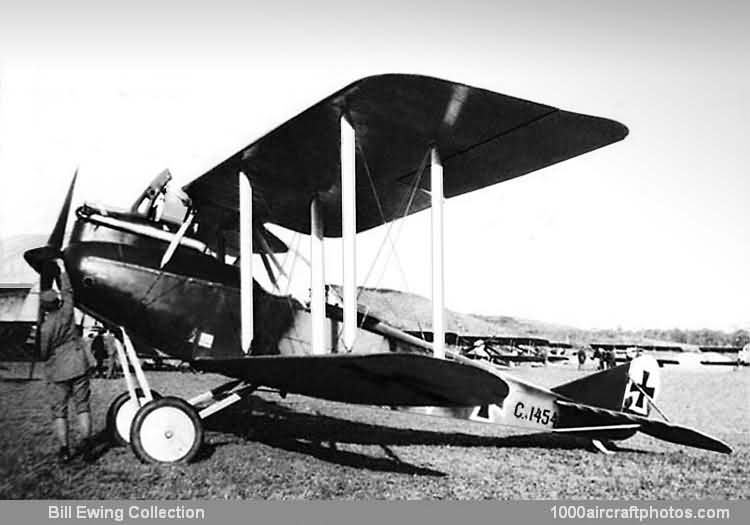08/31/2014. Remarks by Johan Visschedijk: "Development of the highly successful Rumpler C.IV resulted eventually in the appearance, in late 1917, of the C.VII, with still further improved altitude performance. This aircraft was fitted with the high-compression 240 hp Maybach Mb IV six-cylinder watercooled in-line engine. Although the actual horsepower rating was lower than that of the 260 hp Mercedes, the power fall-off at extreme altitudes was much lower, and it was at such heights that the power ratio was seen to advantage. The intermediate C.V was actually a development of the C.III, and there appears to be no record of a C.VI.
Two versions of the Rumpler C.VII existed; the standard machine was used for long-distance reconnaissance and fitted with radio and normal armament of one fixed and one manually operated machine gun. A special photo-reconnaissance version was known as the C.VII (Rubild) and was fitted with specialized camera equipment for most advantageous use at peak altitudes. "Rubild" was a contraction of Rumpler Bildaufklärer (photo reconnaissance). This model dispensed with the forward gun and ammunition, and all extraneous equipment was kept to a minimum. It was the Rumpler C.VII (Rubild) that was the really high-flying Rumpler which often featured in Allied combat reports, and which proved almost impossible to intercept. Its ceiling was in the region of 24,000 ft (7,315 m), and even at 20,000 ft (6,096 m) a speed of 100 mph (161 kmh) could be maintained – a superb performance for the period.
In construction the C.VII was almost identical to the C.IV and differed only in detail. It was marginally smaller in overall dimensions than the C.IV, but the only certain visual identification was by the exhaust manifold, which exhausted sideways to starboard and not upwards as on the earlier machine. The fuselage, as in the C.IV, had a basic structure of timber with steel-tube spacers in the forward half of the fuselage. Nose-entry was not so sleek, as spinners were not fitted to C.VIIs, simply a bulbous metal panel immediately behind the airscrew. Tail surfaces were of steel-tube framing and retained the earlier profile with the distinctive "wing-nut" profile horizontal surfaces. The reverse camber was still featured, and plain elevators were fitted instead of balanced as formerly.
Again the wings were as the C.IV, but with a reduction of just over 4.25 in (11 cm) in span, a slight increase in chord, however, gave a net increase in area of 1 sq.ft (0.09 sq.m)! Unbalanced ailerons of steel-tube framing were fitted, and all interplane struts and center section cabane were interchangeable with those of the C.IV. A slightly longer landing gear chassis gave an increase in height of about 5.25 in (13 cm), which permitted the fitting of airscrews of increased diameter.
The pictured aircraft of Fl.Abt 209 (Feldfliegerabteilung, Field Flying Section) was captured after a battle against the French Lieutenant Covin of the SPA 31 (wing 31 flying SPADs) on October 24, 1917. The crew, Unterofficier Straumer (pilot) and Lieutnant Helmut Joeden (observer), landed the aircraft near Cramaille and was taken prisoner."
